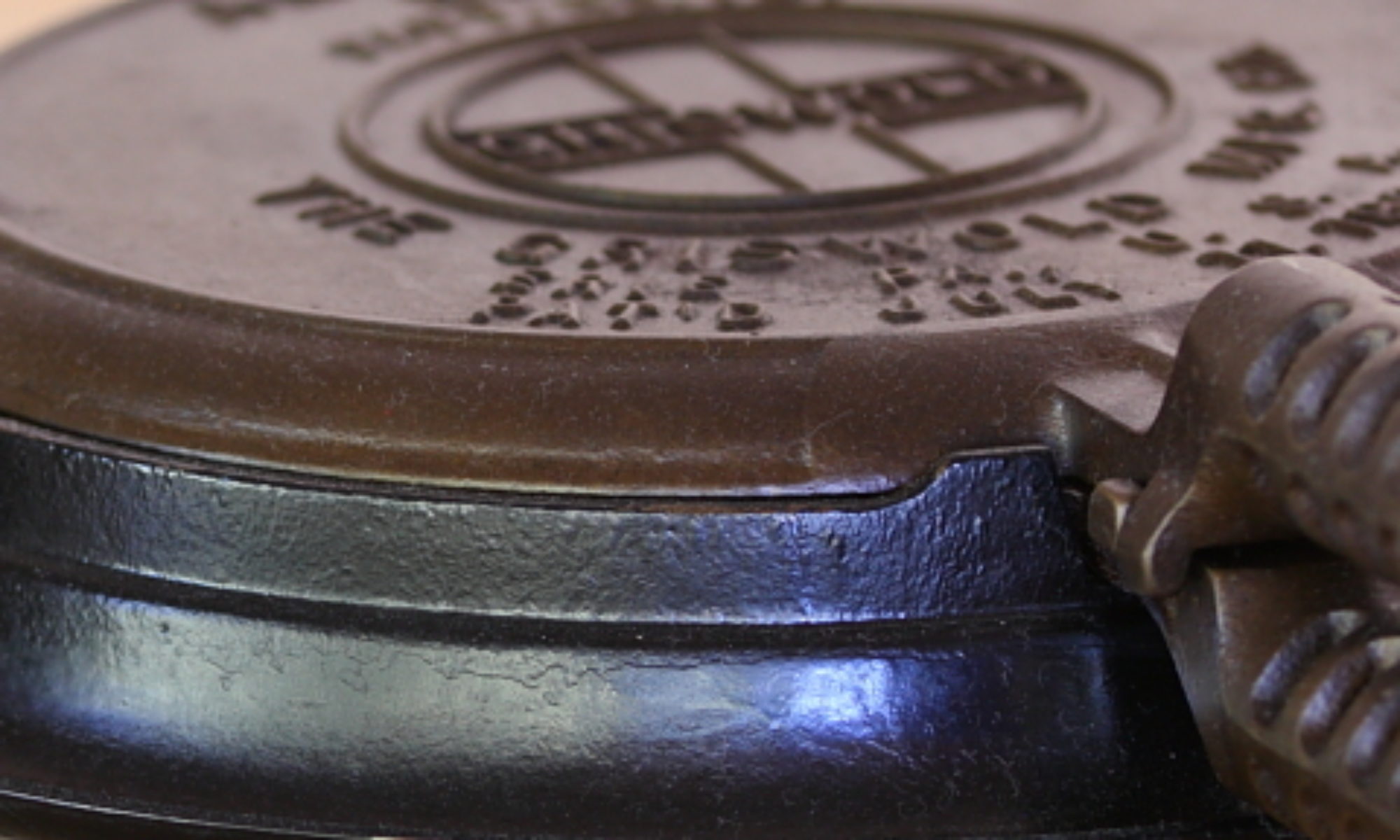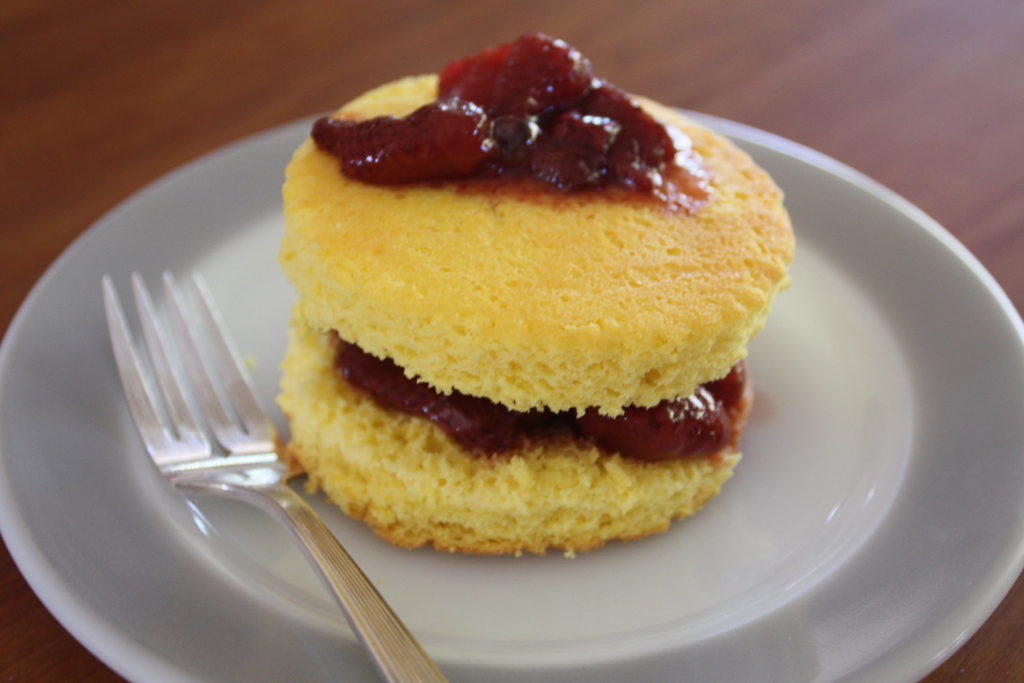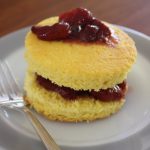
When we saw this recipe in My Kitchen Year, by Ruth Reichl, we were intrigued. First, because it was an old recipe, coming from Mary J. Lincoln via the Boston Cooking School magazine. We like old recipes; there’s just something fun about making a cake that your great-grandparents might have had for a celebration. It gives you a tangible connection with the past. The second reason we liked this recipe was its simplicity — only four ingredients. How can you make a cake with just four ingredients? Read on, fellow scratcher.
Yes, this cake is made from eggs, sugar, flour, and a lemon. No baking powder, no salt, no vanilla: just those four ingredients (well, we do use butter to grease the pan, so, technically, it’s five ingredients). Now, who wouldn’t want to try a cake like that? We made it up one afternoon to use as a base for some of our Roasted Balsamic Strawberries, but we think this cake can be used anywhere a nice-tasting light cake is needed. Possibilities would be for tiramisu, or just slicing into two layers and filling with pastry cream and fruit.
We modified the original recipe to make it easier to make — basically, we have you add sugar to the egg whites while whipping to form a French meringue, which is much harder to over-whip and easier to fold into the batter than plain whipped egg whites. Other than that, it’s the original.
Sponge Cake
Ingredients
- Butter for greasing
- 4 large eggs separated
- 1 cup sugar, divided (200 g)
- Juice and zest from 1 small lemon
- 1 cup cake flour (100 g)
Instructions
- Preheat oven to 350°F. Butter the bottom of an 8x8-inch baking dish. Line with parchment and butter the parchment. Do not butter the sides of the pan.
- Place the egg whites in the mixer bowl fitted with the whisk attachment and start whipping on medium-low. Slowly add about 1/4 cup of sugar, then increase speed to high and whip until the whites have formed stiff peaks, about 3 minutes. Transfer to a large bowl.
- Place egg yolks in the mixer bowl -- no need to clean -- and whip on high until thick and pale yellow, 5 minutes. Slowly add remaining sugar and continue to whip for another 2 minutes.
- Add lemon juice and zest and beat in, about 1 minute.
- Using a large spatula, fold egg white mixture into the egg yolk mixture in three additions.
- Sift flour over the top and gently fold in.
- Pour batter into prepared pan and bake 25-30 minutes, or until golden brown on top, cake springs back when pressed lightly, and a skewer inserted into the center comes out clean.
- Let cake cool in pan for 15 minutes. Run a sharp knife around the edges and invert cake to remove from pan. Let cool completely.
Ingredient discussion:
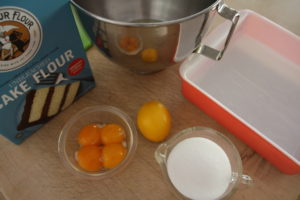
Eggs: they’re best from hens that get to live the way hens should. Out on a pasture eating bugs, grass, and seeds. It’s that simple. While we used a Meyer lemon for our cake, any small lemon will work (or use vanilla or almond flavoring). If you have a large lemon, well, just use half. Finally, cake flour is flour that has less protein than other flours. We think you should use it when the recipe calls for it.
Procedure in detail:
Preheat oven to 350°F. Butter the bottom of an 8×8-inch baking dish and line with a piece of parchment. Butter the parchment. Do not butter the sides. Why? Leaving ungreased sides allow sponge cakes to “climb” the sides while baking, resulting in a cake that’s flat and even. While you’re at it, now is a good time to finish up some mise en place: zest and juice the lemon, separate the eggs, and measure the sugar and flour.
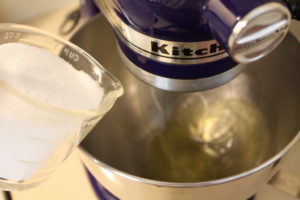
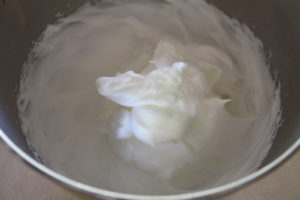
Whip egg whites. Place egg whites in the bowl of a stand mixer fitted with the whisk attachment. Turn the mixer to medium low, and, when the eggs start to get foamy, slowly pour in about 1/4 cup of the sugar. The exact amount doesn’t really matter; we just poured out some from our pre-measured cupful. Let the mixer run for a bit more on medium-low to make sure the sugar is mixed in, then start increasing the speed to high and whip the egg whites until they form stiff, but still glossy, peaks. You’ve just made a French meringue. Believe it or not, it’s an impressive feat. By adding the sugar to the egg whites and whipping, two things are accomplished: first, it makes the egg whites harder to over-whip, and, two, they’re sturdier and less likely to deflate when you fold them into the batter later. Both highly useful. Transfer the egg whites to a bowl.
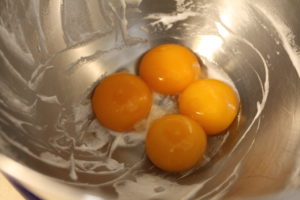
Whip egg yolks. Place the egg yolks in the mixer bowl. No need to clean it first! If you whip the yolks first, then you’ll have to clean the bowl before whipping the whites, so follow the recommended order, unless you like washing dishes. Now, still using the whisk attachment (no need to clean that either), work the mixer up to high and whip the egg yolks until they’re thick and pale yellow. Let the mixer run for a good five minutes; that’s why you have it.
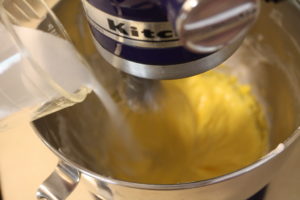
Add sugar. Reduce the speed of the mixer somewhat, and slowly add the remaining sugar. Once added and incorporated, increase the speed of the mixer to high for another 2 full minutes. Of course, if needed, turn off the mixer and scrape down the bowl.
Add flavoring. Turn off the mixer, scrape down the bowl, add the lemon juice and zest, and beat the mixture for another 15 to 20 seconds, or until uniformly mixed.
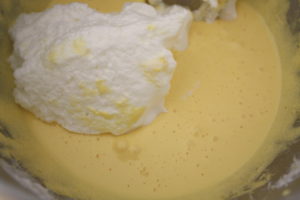
Fold. In three additions, fold the egg whites (or la meringue française, if you prefer) into the egg yolk mixture, forming a nice fluffy final product. See how the meringue holds up while folding it in? Plain old whipped egg whites would be more likely to collapse, making a flatter cake.
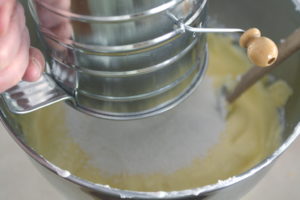
Fold some more. Sift the flour across the top of the mixture and fold it into the egg mixture, forming the cake batter. It’s harder to fold in the flour as it’s dry, but work at it, and, in a minute or so, it’ll all be folded in, while keeping a nice fluffy texture.
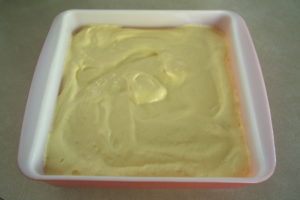
Fill and bake. Scrape the batter into your prepared pan, smoothing off the top. Bake for 25 to 30 minutes, or until the cake is golden brown on top, it springs back when pressed lightly in the center, and a skewer inserted into the center comes out clean.
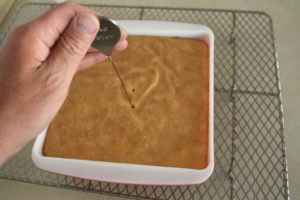
Cool. Let the cake cool for 15 minutes in the pan before using a sharp knife to loosen it along the edges and inverting the pan to have the cake pop out. Remove the parchment, and let the cake cool completely on a baking rack.
Use this cake any time you want a nice light cake. We cut ours in fourths and punched out circles. The circles we cut in half to make two layers, and placed some of our Roasted Balsamic Strawberries between, and on top of the layers. If we’d had whipping cream, that would have gone into the mix. This is one great, and easy, cake: five stars.
